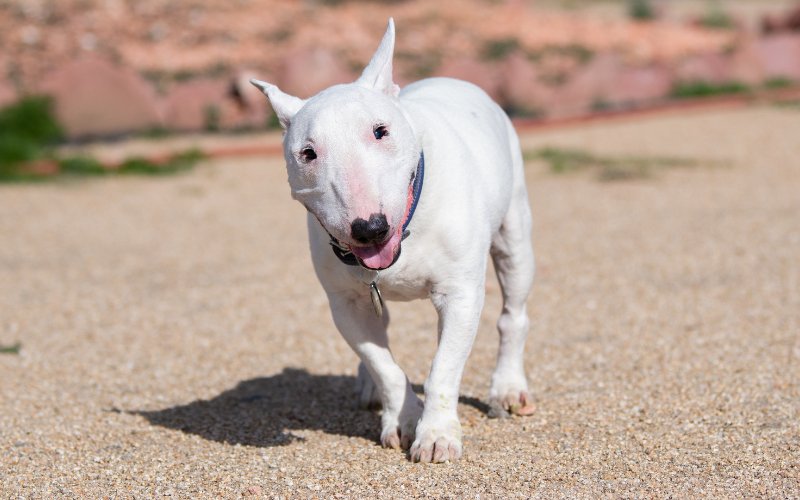
Patellar Luxation in Bull Terriers
|
Time to read 4 min
|
Time to read 4 min
©GoDogPhoto via Canva.com
Patellar luxation, also known as a luxating patella, is a common orthopedic condition that affects many dog breeds, including Bull Terriers. This condition occurs when the kneecap, or patella, moves out of its normal position in the groove of the thighbone, causing discomfort and mobility issues for the affected dog. In this comprehensive guide, we will delve into the causes, symptoms, diagnosis, treatment options, and long-term management of patellar luxation in Bull Terriers. By understanding this condition and taking proactive measures, you can help improve the quality of life for your beloved pet.
The patella plays a crucial role in the proper functioning of a dog's knee joint. It sits in a groove called the trochlear groove, located at the end of the thighbone (femur). In dogs with patellar luxation, the patella either "pops out" or moves out of its normal location, causing varying degrees of discomfort and mobility issues. It can luxate towards the inside (medial) or the outside (lateral) of the leg. Patellar luxation is categorized into four grades based on the severity of the condition.
Patellar luxation can be a congenital condition, meaning dogs are born with it. In some cases, it may develop due to genetic factors, making certain breeds more susceptible to the condition. Bull Terriers are among the breeds that are predisposed to patellar luxation. Other factors that contribute to this condition include:
Recognizing the signs of patellar luxation is crucial for early intervention and effective management. While symptoms may vary depending on the grade of luxation, common signs include:
If you suspect that your Bull Terrier may have patellar luxation, it is essential to consult a veterinarian for a proper diagnosis. Your veterinarian will perform a physical examination, assessing the range of motion in the knee joint and palpating the kneecap. They may also recommend diagnostic imaging, such as X-rays or MRI, to evaluate the severity of the condition and rule out any underlying structural abnormalities.
The treatment approach for patellar luxation in Bull Terriers depends on the grade of luxation and the severity of symptoms. Mild cases may require conservative management, while more severe cases may necessitate surgical intervention. It is important to work closely with your veterinarian to determine the most appropriate treatment plan for your Bull Terrier.
In cases where the luxation is mild or the dog is not experiencing significant discomfort, non-surgical management options may be considered. These can include:
Surgery is often recommended for Bull Terriers with moderate to severe patellar luxation or those experiencing persistent lameness and discomfort. The specific surgical procedure will depend on the grade of luxation and the underlying anatomical abnormalities. Common surgical techniques for treating patellar luxation in Bull Terriers include:
This surgery involves realigning the patella towards the center of the knee joint by adjusting the position of the patellar ligament and deepening the trochlear groove.
In cases where the patella luxates towards the outside of the leg, surgical techniques focus on repositioning the patella towards the center of the knee joint.
This procedure is performed when the groove in the thighbone is shallow. It involves deepening the groove to provide better support and stability for the patella.
In some cases, the insertion point of the patellar ligament may need to be moved to improve alignment and stability.
The surgical approach will be determined by the veterinarian based on the individual needs and condition of your Bull Terrier. It is important to discuss the potential risks, benefits, and expected outcomes of the surgery with your veterinarian beforehand.
Following surgery, proper post-operative care and rehabilitation are essential for a successful recovery. Your veterinarian will provide specific instructions tailored to your Bull Terrier's needs, but general post-surgical care may include:
With proper management and care, the prognosis for Bull Terriers with patellar luxation can be positive. Following surgery, most dogs experience significant improvement in their mobility and quality of life. However, it is important to note that the long-term outlook can vary depending on factors such as the grade of luxation, the presence of any underlying structural abnormalities, and the development of arthritis.
Regular veterinary check-ups are crucial to monitor the condition and address any potential complications early on. Maintaining a healthy weight, providing appropriate exercise, and following any recommended long-term care protocols can help minimize the risk of recurrence and support your Bull Terrier's joint health.
Patellar luxation is a common condition seen in Bull Terriers and other dog breeds. By understanding the causes, symptoms, diagnosis, and treatment options for patellar luxation, you can take proactive steps to ensure your Bull Terrier's well-being. Whether through non-surgical management or surgical intervention, working closely with your veterinarian and following their guidance is crucial for the best possible outcome. With proper care, rehabilitation, and long-term management, your Bull Terrier can lead a happy, active life, free from the discomfort and limitations caused by patellar luxation.